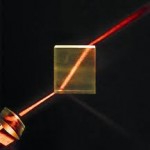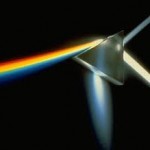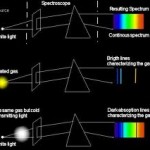Properties
 The speed of light is measured through the equation: v = λ f. However, it turns out that when light is reflected off a surface its speed stays the same. This was first proven by Sir Isaac Newton. Under the assumption of perfectly elastic collision, the laws of reflection follow from the laws of motion. To demonstrate, consider a particle traveling towards a flat frictionless surface whose horizontal and vertical velocity components are: VX and VY. When the particle is reflected from the surface there is no change in VX. The vertical velocity component is reversed in direction because of the reactive force of flat frictionless surface. The magnitude of VY is not changed. Since the collision between the particle and the surface is perfectly elastic there is no change in kinetic energy. This also been proven before by measuring the two variables before and after reflection. In order to change the speed of light, either the frequency or the wavelength has to change. The results have shown equivalent values for both of the variables. Thus indicating and proving that the speed of light stays the same after being reflected off a surface.
The speed of light is measured through the equation: v = λ f. However, it turns out that when light is reflected off a surface its speed stays the same. This was first proven by Sir Isaac Newton. Under the assumption of perfectly elastic collision, the laws of reflection follow from the laws of motion. To demonstrate, consider a particle traveling towards a flat frictionless surface whose horizontal and vertical velocity components are: VX and VY. When the particle is reflected from the surface there is no change in VX. The vertical velocity component is reversed in direction because of the reactive force of flat frictionless surface. The magnitude of VY is not changed. Since the collision between the particle and the surface is perfectly elastic there is no change in kinetic energy. This also been proven before by measuring the two variables before and after reflection. In order to change the speed of light, either the frequency or the wavelength has to change. The results have shown equivalent values for both of the variables. Thus indicating and proving that the speed of light stays the same after being reflected off a surface.
Refraction
 Refraction is the bending of light through a substance. Different substances bend light at different angles. White light is made up of a full spectrum of colors. Each color has a different wavelength, and bends at a different angle. This is the same effect that produces rainbows in the atmosphere. The most common illustration of this is a glass prism. When light enters a material such as glass, the light slows down. That’s because the electric charges in the material delay a light wave by interacting with the wave’s electric and magnetic fields. The higher the frequency of the light wave, the more it interacts with the charges in most materials and the more that light wave slows down. Thus high-frequency violet light slows more than low-frequency red light as the two enter a piece of glass. Because of this slowing effect, light bends when it encounters a glass surface at an angle. The wave has a width and as it encounters the glass surface, one side of the wave reaches the glass before the other side of the wave. Since the side that arrives first also slows first, the whole wave bends so that it travels more directly into the glass. Since violet light slows more than red light, the violet light also bends more than the red light. The two colors thus follow different paths through the glass. The same bending occurs in reverse when the light leaves the glass. Light speeds up as it leaves glass and again the violet light bends more than the red light. In a prism (or any carefully cut glass, crystal, or plastic), the colors of light bend differently at each surface and follow slightly different paths both in and out of the prism. The light rays then appear separately when they strike a surface outside the prism or when you look at those light rays with your eyes.
Refraction is the bending of light through a substance. Different substances bend light at different angles. White light is made up of a full spectrum of colors. Each color has a different wavelength, and bends at a different angle. This is the same effect that produces rainbows in the atmosphere. The most common illustration of this is a glass prism. When light enters a material such as glass, the light slows down. That’s because the electric charges in the material delay a light wave by interacting with the wave’s electric and magnetic fields. The higher the frequency of the light wave, the more it interacts with the charges in most materials and the more that light wave slows down. Thus high-frequency violet light slows more than low-frequency red light as the two enter a piece of glass. Because of this slowing effect, light bends when it encounters a glass surface at an angle. The wave has a width and as it encounters the glass surface, one side of the wave reaches the glass before the other side of the wave. Since the side that arrives first also slows first, the whole wave bends so that it travels more directly into the glass. Since violet light slows more than red light, the violet light also bends more than the red light. The two colors thus follow different paths through the glass. The same bending occurs in reverse when the light leaves the glass. Light speeds up as it leaves glass and again the violet light bends more than the red light. In a prism (or any carefully cut glass, crystal, or plastic), the colors of light bend differently at each surface and follow slightly different paths both in and out of the prism. The light rays then appear separately when they strike a surface outside the prism or when you look at those light rays with your eyes.
Dispersion
 The dispersion of colors in a prism occurs because of something called the refractive index of the glass. Every material has a different refractive index. When light enters a material (for example, when light traveling through the air enters the glass of a prism), the difference in the refractive index of air and glass causes the light to bend. The angle of bending is different for different wavelengths of light. As the white light moves through the two faces of the prism, the different colors bend different amounts and in doing so spread out into a rainbow. In a rainbow, raindrops in the air act as tiny prisms. Light enters the raindrop, reflects off of the side of the drop and exits. In the process, it is broken into a spectrum just like it is in a triangular glass prism. When light enters the raindrop it slows down. As we know white light is made up on of 7 different colors. The high-frequency violet light slows down more than the low-frequency red light as they enter the rain drop and the light refracts as it enters a new medium. The wave has an angle as it approaches the raindrop so; one side of the wave reaches the glass before the other side of the wave. Since the side that arrives first also slows first, the whole wave refracts so that it travels more directly into the glass. Since violet light slows more than red light, the violet light also bends more than the red light. The two colors thus follow different paths through the glass. The same bending occurs in reverse when the light leaves the glass. Light speeds up as it leaves raindrop and again the violet light bends more than the red light. Since the violet light bends the most out of all the color, it is always at the bottom. On the other hand, the red light refracts the least thus always being on top of the rainbow.
The dispersion of colors in a prism occurs because of something called the refractive index of the glass. Every material has a different refractive index. When light enters a material (for example, when light traveling through the air enters the glass of a prism), the difference in the refractive index of air and glass causes the light to bend. The angle of bending is different for different wavelengths of light. As the white light moves through the two faces of the prism, the different colors bend different amounts and in doing so spread out into a rainbow. In a rainbow, raindrops in the air act as tiny prisms. Light enters the raindrop, reflects off of the side of the drop and exits. In the process, it is broken into a spectrum just like it is in a triangular glass prism. When light enters the raindrop it slows down. As we know white light is made up on of 7 different colors. The high-frequency violet light slows down more than the low-frequency red light as they enter the rain drop and the light refracts as it enters a new medium. The wave has an angle as it approaches the raindrop so; one side of the wave reaches the glass before the other side of the wave. Since the side that arrives first also slows first, the whole wave refracts so that it travels more directly into the glass. Since violet light slows more than red light, the violet light also bends more than the red light. The two colors thus follow different paths through the glass. The same bending occurs in reverse when the light leaves the glass. Light speeds up as it leaves raindrop and again the violet light bends more than the red light. Since the violet light bends the most out of all the color, it is always at the bottom. On the other hand, the red light refracts the least thus always being on top of the rainbow.
Spectroscope
 A spectroscope is an optical device for producing and observing a spectrum of light or radiation from any source. The device is usually made up of slit through which light or radiation passes, a collimating lens and a prism. A spectroscope works by breaking light into the wavelengths (or spectra) that make it up. When light hits the lines, it bends. Different wavelengths (colors) of light bend by different amounts, so it splits the light into its colors. Other spectroscopes are made of prisms- as light passes through the glass, the different wavelengths slow down by different amounts and are bent into their colors. Scientists can tell the elements present in a star by looking at its light through a spectroscope. Each element will have its own unique spectral lines of color, just as people each have a unique fingerprint. This field of study is used to study atoms because as electrons gain or lose energy they release their own spectra lines. We looked at the wall of the spectroscope because that is where the light was shined and where the spectrum was being showed.
A spectroscope is an optical device for producing and observing a spectrum of light or radiation from any source. The device is usually made up of slit through which light or radiation passes, a collimating lens and a prism. A spectroscope works by breaking light into the wavelengths (or spectra) that make it up. When light hits the lines, it bends. Different wavelengths (colors) of light bend by different amounts, so it splits the light into its colors. Other spectroscopes are made of prisms- as light passes through the glass, the different wavelengths slow down by different amounts and are bent into their colors. Scientists can tell the elements present in a star by looking at its light through a spectroscope. Each element will have its own unique spectral lines of color, just as people each have a unique fingerprint. This field of study is used to study atoms because as electrons gain or lose energy they release their own spectra lines. We looked at the wall of the spectroscope because that is where the light was shined and where the spectrum was being showed.
